Input interpretation

firefly luciferin
Chemical names and formulas
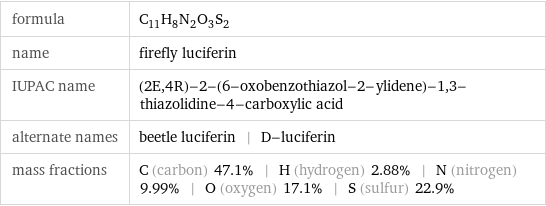
formula | C_11H_8N_2O_3S_2 name | firefly luciferin IUPAC name | (2E, 4R)-2-(6-oxobenzothiazol-2-ylidene)-1, 3-thiazolidine-4-carboxylic acid alternate names | beetle luciferin | D-luciferin mass fractions | C (carbon) 47.1% | H (hydrogen) 2.88% | N (nitrogen) 9.99% | O (oxygen) 17.1% | S (sulfur) 22.9%
Lewis structure
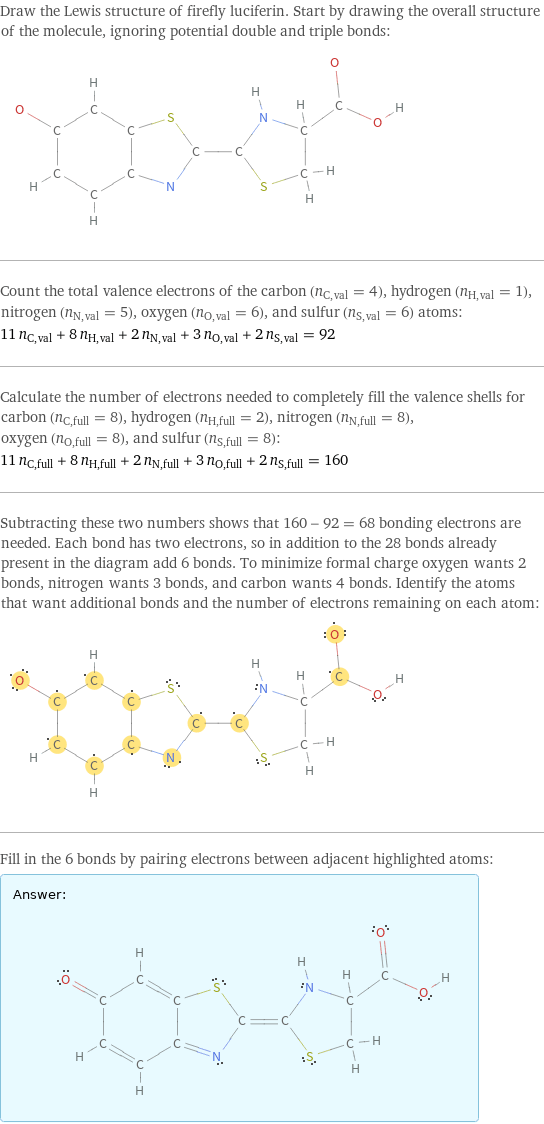
Draw the Lewis structure of firefly luciferin. Start by drawing the overall structure of the molecule, ignoring potential double and triple bonds: Count the total valence electrons of the carbon (n_C, val = 4), hydrogen (n_H, val = 1), nitrogen (n_N, val = 5), oxygen (n_O, val = 6), and sulfur (n_S, val = 6) atoms: 11 n_C, val + 8 n_H, val + 2 n_N, val + 3 n_O, val + 2 n_S, val = 92 Calculate the number of electrons needed to completely fill the valence shells for carbon (n_C, full = 8), hydrogen (n_H, full = 2), nitrogen (n_N, full = 8), oxygen (n_O, full = 8), and sulfur (n_S, full = 8): 11 n_C, full + 8 n_H, full + 2 n_N, full + 3 n_O, full + 2 n_S, full = 160 Subtracting these two numbers shows that 160 - 92 = 68 bonding electrons are needed. Each bond has two electrons, so in addition to the 28 bonds already present in the diagram add 6 bonds. To minimize formal charge oxygen wants 2 bonds, nitrogen wants 3 bonds, and carbon wants 4 bonds. Identify the atoms that want additional bonds and the number of electrons remaining on each atom: Fill in the 6 bonds by pairing electrons between adjacent highlighted atoms: Answer: | |
3D structure
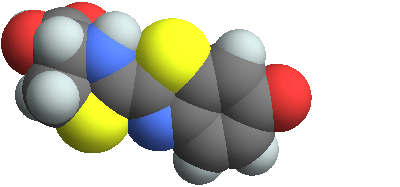
3D structure
Basic properties
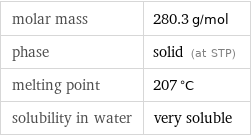
molar mass | 280.3 g/mol phase | solid (at STP) melting point | 207 °C solubility in water | very soluble
Units

Chemical identifiers
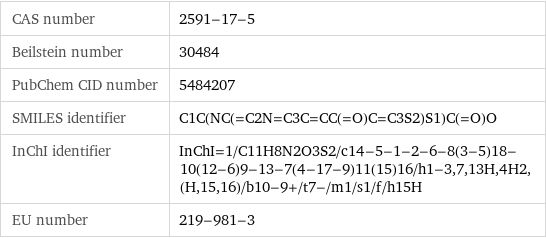
CAS number | 2591-17-5 Beilstein number | 30484 PubChem CID number | 5484207 SMILES identifier | C1C(NC(=C2N=C3C=CC(=O)C=C3S2)S1)C(=O)O InChI identifier | InChI=1/C11H8N2O3S2/c14-5-1-2-6-8(3-5)18-10(12-6)9-13-7(4-17-9)11(15)16/h1-3, 7, 13H, 4H2, (H, 15, 16)/b10-9+/t7-/m1/s1/f/h15H EU number | 219-981-3